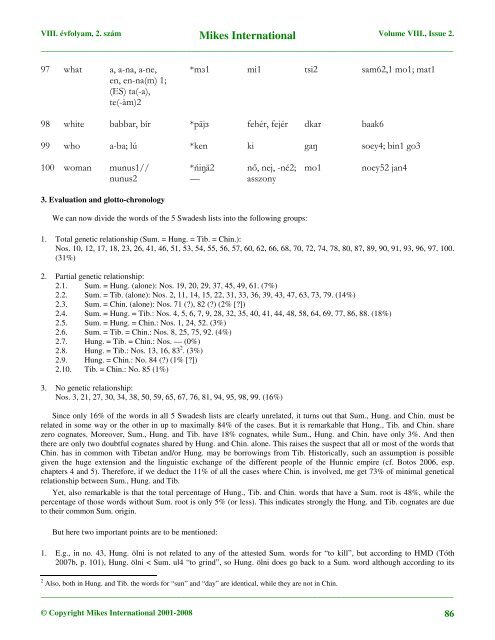Mikes International - Hollandiai Magyar Szövetség
Mikes International - Hollandiai Magyar Szövetség
Mikes International - Hollandiai Magyar Szövetség
Create successful ePaper yourself
Turn your PDF publications into a flip-book with our unique Google optimized e-Paper software.
VIII. évfolyam, 2. szám <strong>Mikes</strong> <strong>International</strong> Volume VIII., Issue 2.<br />
_____________________________________________________________________________________<br />
97 what a, a-na, a-ne, *mз1 mi1 tsi2 sam62,1 mo1; mat1<br />
en, en-na(m) 1;<br />
(ES) ta(-a),<br />
te(-àm)2<br />
98 white babbar, bír *päjз fehér, fejér dkar baak6<br />
99 who a-ba; lú *ken ki gaŋ soey4; bin1 go3<br />
100 woman munus1// *ńiŋä2 nő, nej, -né2; mo1 noey52 jan4<br />
nunus2 — asszony<br />
3. Evaluation and glotto-chronology<br />
We can now divide the words of the 5 Swadesh lists into the following groups:<br />
1. Total genetic relationship (Sum. = Hung. = Tib. = Chin.):<br />
Nos. 10, 12, 17, 18, 23, 26, 41, 46, 51, 53, 54, 55, 56, 57, 60, 62, 66, 68, 70, 72, 74, 78, 80, 87, 89, 90, 91, 93, 96, 97, 100.<br />
(31%)<br />
2. Partial genetic relationship:<br />
2.1. Sum. = Hung. (alone): Nos. 19, 20, 29, 37, 45, 49, 61. (7%)<br />
2.2. Sum. = Tib. (alone): Nos. 2, 11, 14, 15, 22, 31, 33, 36, 39, 43, 47, 63, 73, 79. (14%)<br />
2.3. Sum. = Chin. (alone): Nos. 71 (?), 82 (?) (2% [?])<br />
2.4. Sum. = Hung. = Tib.: Nos. 4, 5, 6, 7, 9, 28, 32, 35, 40, 41, 44, 48, 58, 64, 69, 77, 86, 88. (18%)<br />
2.5. Sum. = Hung. = Chin.: Nos. 1, 24, 52. (3%)<br />
2.6. Sum. = Tib. = Chin.: Nos. 8, 25, 75, 92. (4%)<br />
2.7. Hung. = Tib. = Chin.: Nos. — (0%)<br />
2.8. Hung. = Tib.: Nos. 13, 16, 83 2 . (3%)<br />
2.9. Hung. = Chin.: No. 84 (?) (1% [?])<br />
2.10. Tib. = Chin.: No. 85 (1%)<br />
3. No genetic relationship:<br />
Nos. 3, 21, 27, 30, 34, 38, 50, 59, 65, 67, 76, 81, 94, 95, 98, 99. (16%)<br />
Since only 16% of the words in all 5 Swadesh lists are clearly unrelated, it turns out that Sum., Hung. and Chin. must be<br />
related in some way or the other in up to maximally 84% of the cases. But it is remarkable that Hung., Tib. and Chin. share<br />
zero cognates. Moreover, Sum., Hung. and Tib. have 18% cognates, while Sum., Hung. and Chin. have only 3%. And then<br />
there are only two doubtful cognates shared by Hung. and Chin. alone. This raises the suspect that all or most of the words that<br />
Chin. has in common with Tibetan and/or Hung. may be borrowings from Tib. Historically, such an assumption is possible<br />
given the huge extension and the linguistic exchange of the different people of the Hunnic empire (cf. Botos 2006, esp.<br />
chapters 4 and 5). Therefore, if we deduct the 11% of all the cases where Chin. is involved, me get 73% of minimal genetical<br />
relationship between Sum., Hung. and Tib.<br />
Yet, also remarkable is that the total percentage of Hung., Tib. and Chin. words that have a Sum. root is 48%, while the<br />
percentage of those words without Sum. root is only 5% (or less). This indicates strongly the Hung. and Tib. cognates are due<br />
to their common Sum. origin.<br />
But here two important points are to be mentioned:<br />
1. E.g., in no. 43, Hung. ölni is not related to any of the attested Sum. words for “to kill”, but according to HMD (Tóth<br />
2007b, p. 101), Hung. ölni < Sum. ul4 “to grind”, so Hung. ölni does go back to a Sum. word although according to its<br />
2 Also, both in Hung. and Tib. the words for “sun” and “day” are identical, while they are not in Chin.<br />
_____________________________________________________________________________________<br />
© Copyright <strong>Mikes</strong> <strong>International</strong> 2001-2008 86

















